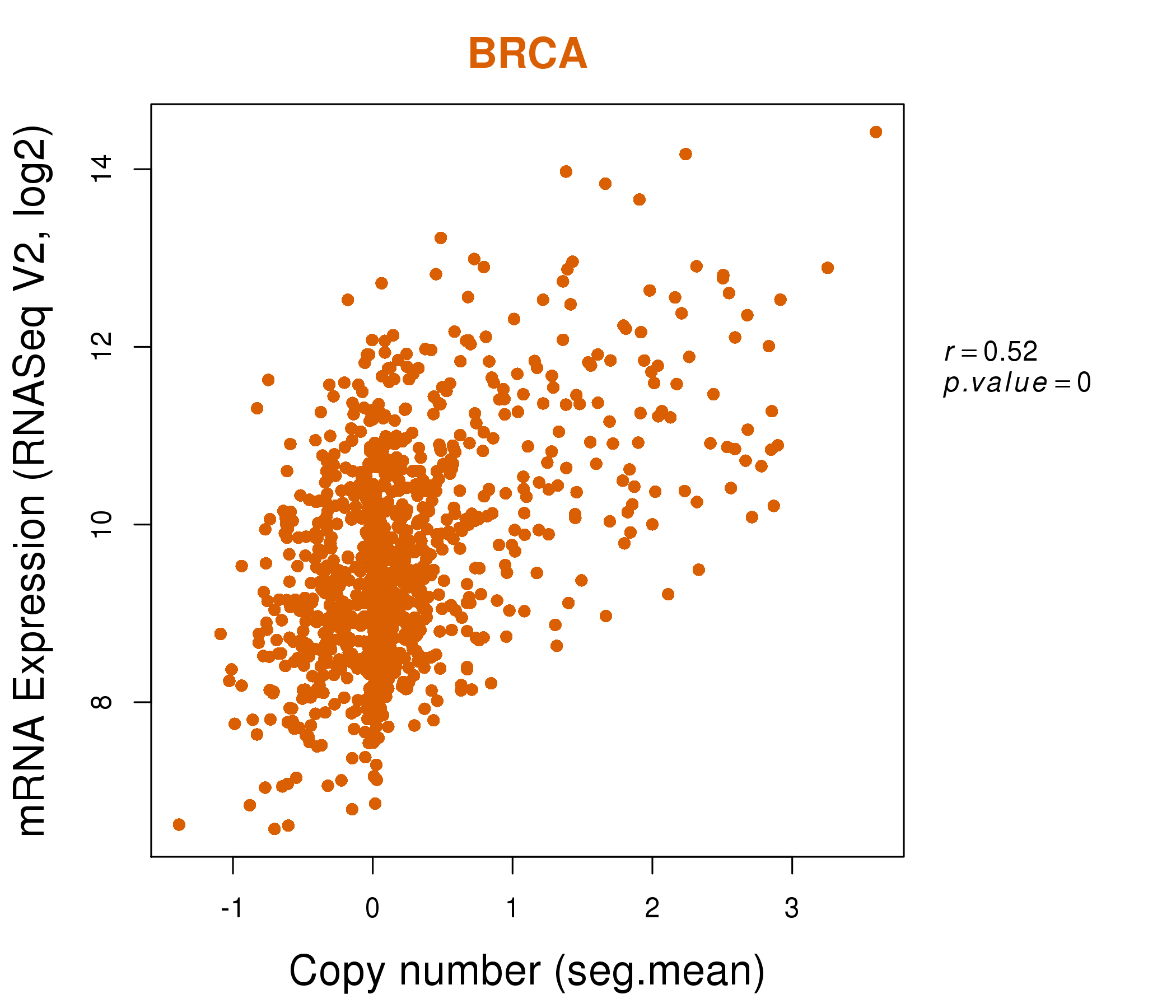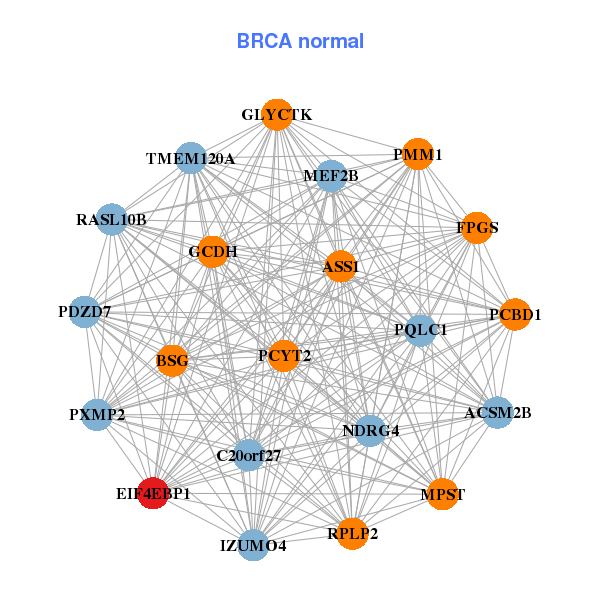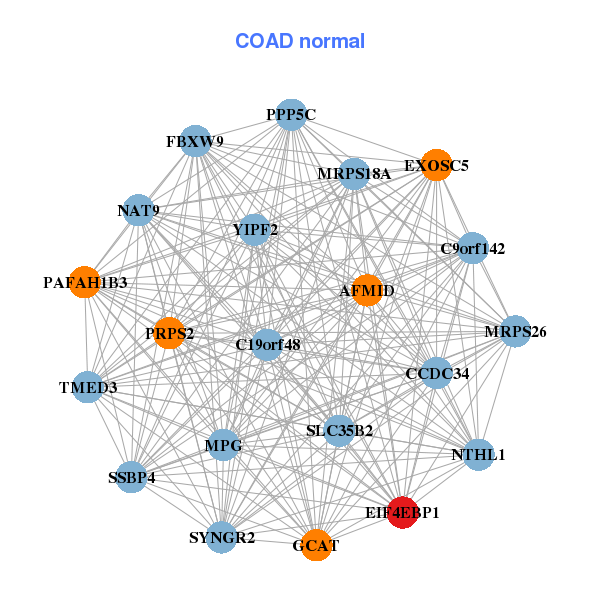|
|||||||||||||||||||||||||||||||||||||||||||||||||||||||||||||||||||||||||||||||||||||||||||||||||||||||||||||||||||||||||||||||||||||||||||||||||||||||||||||||||||||||||||||||||||||||||||||||||||||||||||||||||||||||||||||||||||||||||||||||||||||||||||||||||||||||||||||||||||||||||||||||||||||||||||||||||||||||||||||||||||||||||||||||||||||||
| |
| Phenotypic Information (metabolism pathway, cancer, disease, phenome) |
| |
| |
| Gene-Gene Network Information: Co-Expression Network, Interacting Genes & KEGG |
| |
|
| Gene Summary for EIF4EBP1 |
| Basic gene info. | Gene symbol | EIF4EBP1 |
| Gene name | eukaryotic translation initiation factor 4E binding protein 1 | |
| Synonyms | 4E-BP1|4EBP1|BP-1|PHAS-I | |
| Cytomap | UCSC genome browser: 8p12 | |
| Genomic location | chr8 :37888019-37917883 | |
| Type of gene | protein-coding | |
| RefGenes | NM_004095.3, | |
| Ensembl id | ENSG00000187840 | |
| Description | eIF4E-binding protein 1eukaryotic translation initiation factor 4E-binding protein 1phosphorylated heat- and acid-stable protein regulated by insulin 1 | |
| Modification date | 20141222 | |
| dbXrefs | MIM : 602223 | |
| HGNC : HGNC | ||
| Ensembl : ENSG00000187840 | ||
| HPRD : 03746 | ||
| Vega : OTTHUMG00000164012 | ||
| Protein | UniProt: Q13541 go to UniProt's Cross Reference DB Table | |
| Expression | CleanEX: HS_EIF4EBP1 | |
| BioGPS: 1978 | ||
| Gene Expression Atlas: ENSG00000187840 | ||
| The Human Protein Atlas: ENSG00000187840 | ||
| Pathway | NCI Pathway Interaction Database: EIF4EBP1 | |
| KEGG: EIF4EBP1 | ||
| REACTOME: EIF4EBP1 | ||
| ConsensusPathDB | ||
| Pathway Commons: EIF4EBP1 | ||
| Metabolism | MetaCyc: EIF4EBP1 | |
| HUMANCyc: EIF4EBP1 | ||
| Regulation | Ensembl's Regulation: ENSG00000187840 | |
| miRBase: chr8 :37,888,019-37,917,883 | ||
| TargetScan: NM_004095 | ||
| cisRED: ENSG00000187840 | ||
| Context | iHOP: EIF4EBP1 | |
| cancer metabolism search in PubMed: EIF4EBP1 | ||
| UCL Cancer Institute: EIF4EBP1 | ||
| Assigned class in ccmGDB | A - This gene has a literature evidence and it belongs to cancer gene. | |
| References showing role of EIF4EBP1 in cancer cell metabolism | 1. Teo T, Yu M, Yang Y, Gillam T, Lam F, et al. (2015) Pharmacologic co-inhibition of Mnks and mTORC1 synergistically suppresses proliferation and perturbs cell cycle progression in blast crisis-chronic myeloid leukemia cells. Cancer Lett 357: 612-623. doi: 10.1016/j.canlet.2014.12.029. go to article 2. Hsu HS, Lin MH, Jang YH, Kuo TT, Liu CC, et al. (2015) The 4E-BP1/eIF4E ratio is a determinant for rapamycin response in esophageal cancer cells. J Thorac Cardiovasc Surg 149: 378-385. doi: 10.1016/j.jtcvs.2014.09.047. go to article 3. Andrikopoulou M, Salakos N, Deligeoroglou E, Pafiti A, Boutas I, et al. (2015) The role of mTOR signaling pathway in premalignant and malignant cervical lesions. Eur J Gynaecol Oncol 36: 36-43. go to article | |
| Top |
| Phenotypic Information for EIF4EBP1(metabolism pathway, cancer, disease, phenome) |
| Cancer | CGAP: EIF4EBP1 |
| Familial Cancer Database: EIF4EBP1 | |
| * This gene is included in those cancer gene databases. |
|
|
|
|
|
| . | |||||||||||||||||||||||||||||||||||||||||||||||||||||||||||||||||||||||||||||||||||||||||||||||||||||||||||||||||||||||||||||||||||||||||||||||||||||||||||||||||||||||||||||||||||||||||||||||||||||||||||||||||||||||||||||||||||||||||||||||||||||||||||||||||||||||||||||||||||||||||||||||||||||||||||||||||||||||||||||||||||||||||||||||||
Oncogene 1 | Significant driver gene in | ||||||||||||||||||||||||||||||||||||||||||||||||||||||||||||||||||||||||||||||||||||||||||||||||||||||||||||||||||||||||||||||||||||||||||||||||||||||||||||||||||||||||||||||||||||||||||||||||||||||||||||||||||||||||||||||||||||||||||||||||||||||||||||||||||||||||||||||||||||||||||||||||||||||||||||||||||||||||||||||||||||||||||||||||||||||
| cf) number; DB name 1 Oncogene; http://nar.oxfordjournals.org/content/35/suppl_1/D721.long, 2 Tumor Suppressor gene; https://bioinfo.uth.edu/TSGene/, 3 Cancer Gene Census; http://www.nature.com/nrc/journal/v4/n3/abs/nrc1299.html, 4 CancerGenes; http://nar.oxfordjournals.org/content/35/suppl_1/D721.long, 5 Network of Cancer Gene; http://ncg.kcl.ac.uk/index.php, 1Therapeutic Vulnerabilities in Cancer; http://cbio.mskcc.org/cancergenomics/statius/ |
| REACTOME_METABOLISM_OF_PROTEINS | |
| Mutations for EIF4EBP1 |
| * Under tables are showing count per each tissue to give us broad intuition about tissue specific mutation patterns.You can go to the detailed page for each mutation database's web site. |
| There's no structural variation information in COSMIC data for this gene. |
| * From mRNA Sanger sequences, Chitars2.0 arranged chimeric transcripts. This table shows EIF4EBP1 related fusion information. |
| ID | Head Gene | Tail Gene | Accession | Gene_a | qStart_a | qEnd_a | Chromosome_a | tStart_a | tEnd_a | Gene_a | qStart_a | qEnd_a | Chromosome_a | tStart_a | tEnd_a |
| Top |
| Mutation type/ Tissue ID | brca | cns | cerv | endome | haematopo | kidn | Lintest | liver | lung | ns | ovary | pancre | prost | skin | stoma | thyro | urina | |||
| Total # sample | 2 | 1 | ||||||||||||||||||
| GAIN (# sample) | 1 | 1 | ||||||||||||||||||
| LOSS (# sample) | 2 |
| cf) Tissue ID; Tissue type (1; Breast, 2; Central_nervous_system, 3; Cervix, 4; Endometrium, 5; Haematopoietic_and_lymphoid_tissue, 6; Kidney, 7; Large_intestine, 8; Liver, 9; Lung, 10; NS, 11; Ovary, 12; Pancreas, 13; Prostate, 14; Skin, 15; Stomach, 16; Thyroid, 17; Urinary_tract) |
| Top |
|
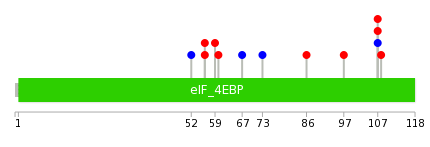 |
| Top |
| Stat. for Non-Synonymous SNVs (# total SNVs=5) | (# total SNVs=3) |
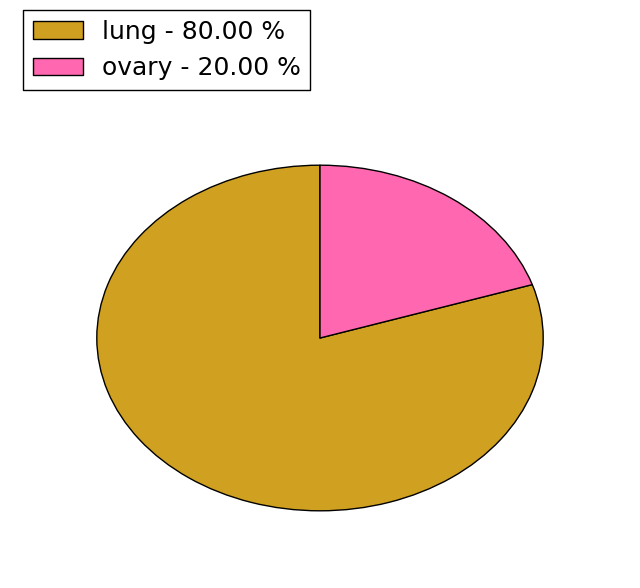 | 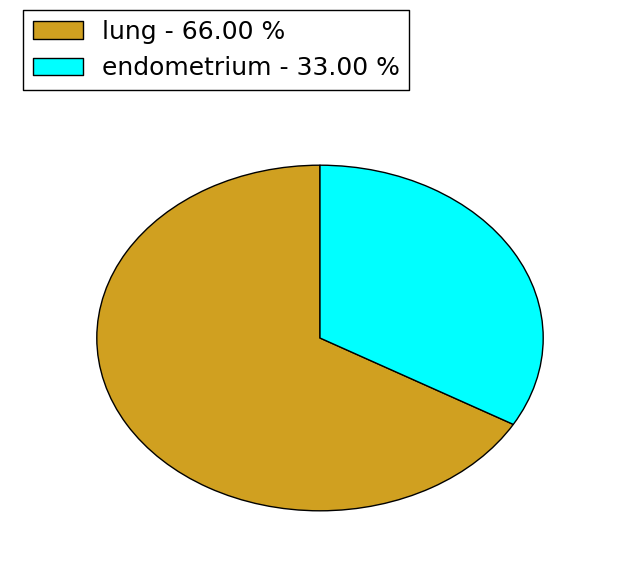 |
(# total SNVs=0) | (# total SNVs=0) |
| Top |
| * When you move the cursor on each content, you can see more deailed mutation information on the Tooltip. Those are primary_site,primary_histology,mutation(aa),pubmedID. |
| GRCh37 position | Mutation(aa) | Unique sampleID count |
| chr8:37914744-37914744 | p.H97Q | 1 |
| chr8:37914772-37914772 | p.A107T | 1 |
| chr8:37914773-37914773 | p.A107V | 1 |
| chr8:37914609-37914609 | p.I52I | 1 |
| chr8:37914774-37914774 | p.A107A | 1 |
| chr8:37914619-37914619 | p.R56W | 1 |
| chr8:37914775-37914775 | p.G108C | 1 |
| chr8:37914620-37914620 | p.R56Q | 1 |
| chr8:37914629-37914629 | p.L59Q | 1 |
| chr8:37914633-37914633 | p.M60I | 1 |
| Top |
|
 |
| Point Mutation/ Tissue ID | 1 | 2 | 3 | 4 | 5 | 6 | 7 | 8 | 9 | 10 | 11 | 12 | 13 | 14 | 15 | 16 | 17 | 18 | 19 | 20 |
| # sample | 1 | 2 | 1 | 1 | 2 | 2 | 1 | |||||||||||||
| # mutation | 1 | 2 | 1 | 1 | 2 | 2 | 1 | |||||||||||||
| nonsynonymous SNV | 1 | 1 | 1 | 1 | 2 | |||||||||||||||
| synonymous SNV | 1 | 1 | 1 | 1 |
| cf) Tissue ID; Tissue type (1; BLCA[Bladder Urothelial Carcinoma], 2; BRCA[Breast invasive carcinoma], 3; CESC[Cervical squamous cell carcinoma and endocervical adenocarcinoma], 4; COAD[Colon adenocarcinoma], 5; GBM[Glioblastoma multiforme], 6; Glioma Low Grade, 7; HNSC[Head and Neck squamous cell carcinoma], 8; KICH[Kidney Chromophobe], 9; KIRC[Kidney renal clear cell carcinoma], 10; KIRP[Kidney renal papillary cell carcinoma], 11; LAML[Acute Myeloid Leukemia], 12; LUAD[Lung adenocarcinoma], 13; LUSC[Lung squamous cell carcinoma], 14; OV[Ovarian serous cystadenocarcinoma ], 15; PAAD[Pancreatic adenocarcinoma], 16; PRAD[Prostate adenocarcinoma], 17; SKCM[Skin Cutaneous Melanoma], 18:STAD[Stomach adenocarcinoma], 19:THCA[Thyroid carcinoma], 20:UCEC[Uterine Corpus Endometrial Carcinoma]) |
| Top |
| * We represented just top 10 SNVs. When you move the cursor on each content, you can see more deailed mutation information on the Tooltip. Those are primary_site, primary_histology, mutation(aa), pubmedID. |
| Genomic Position | Mutation(aa) | Unique sampleID count |
| chr8:37914654 | p.V67V | 2 |
| chr8:37914778 | p.I52I | 1 |
| chr8:37914609 | p.R56W | 1 |
| chr8:37914619 | p.R56Q | 1 |
| chr8:37914620 | p.R73R | 1 |
| chr8:37914672 | p.S86N | 1 |
| chr8:37914710 | p.H97Q | 1 |
| chr8:37914744 | p.A107V | 1 |
| chr8:37914773 | p.G109C | 1 |
| * Copy number data were extracted from TCGA using R package TCGA-Assembler. The URLs of all public data files on TCGA DCC data server were gathered on Jan-05-2015. Function ProcessCNAData in TCGA-Assembler package was used to obtain gene-level copy number value which is calculated as the average copy number of the genomic region of a gene. |
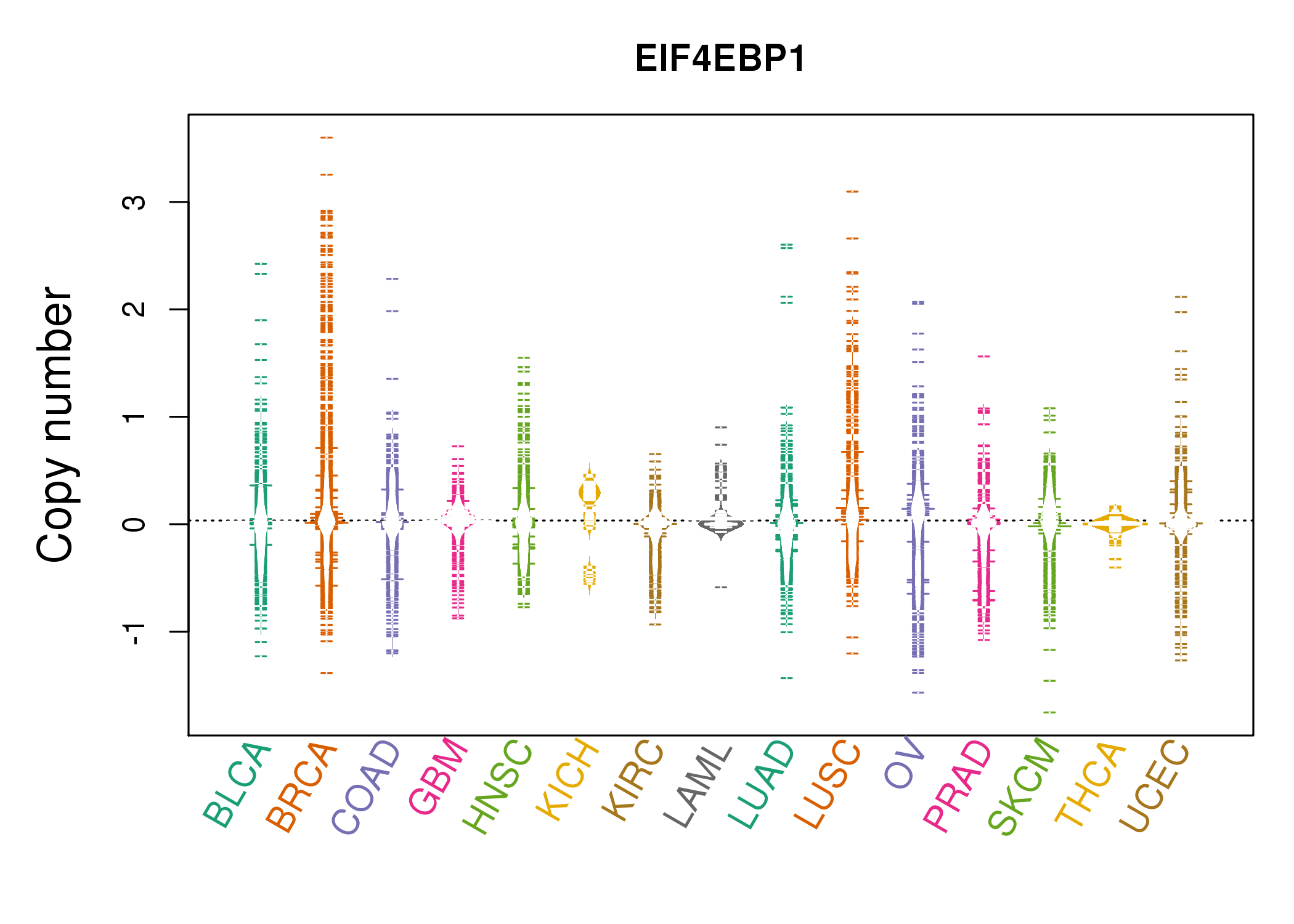 |
| cf) Tissue ID[Tissue type]: BLCA[Bladder Urothelial Carcinoma], BRCA[Breast invasive carcinoma], CESC[Cervical squamous cell carcinoma and endocervical adenocarcinoma], COAD[Colon adenocarcinoma], GBM[Glioblastoma multiforme], Glioma Low Grade, HNSC[Head and Neck squamous cell carcinoma], KICH[Kidney Chromophobe], KIRC[Kidney renal clear cell carcinoma], KIRP[Kidney renal papillary cell carcinoma], LAML[Acute Myeloid Leukemia], LUAD[Lung adenocarcinoma], LUSC[Lung squamous cell carcinoma], OV[Ovarian serous cystadenocarcinoma ], PAAD[Pancreatic adenocarcinoma], PRAD[Prostate adenocarcinoma], SKCM[Skin Cutaneous Melanoma], STAD[Stomach adenocarcinoma], THCA[Thyroid carcinoma], UCEC[Uterine Corpus Endometrial Carcinoma] |
| Top |
| Gene Expression for EIF4EBP1 |
| * CCLE gene expression data were extracted from CCLE_Expression_Entrez_2012-10-18.res: Gene-centric RMA-normalized mRNA expression data. |
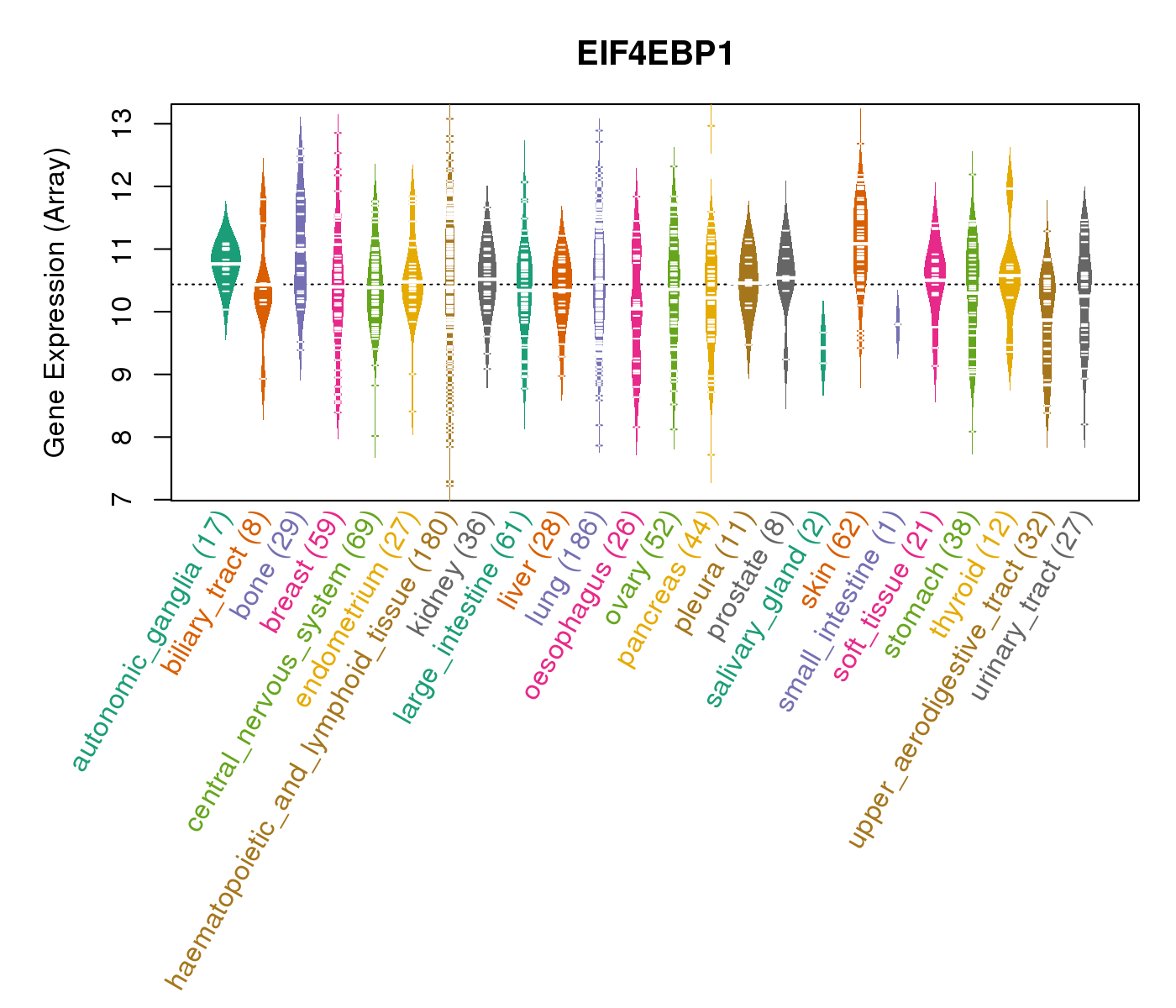 |
| Top |
| *RPPA protein expression data were extracted from TCPA (The Cancer Proteome Atlas). Normalized data based on replicated based normalization (RBN) was used to draw following figures. |
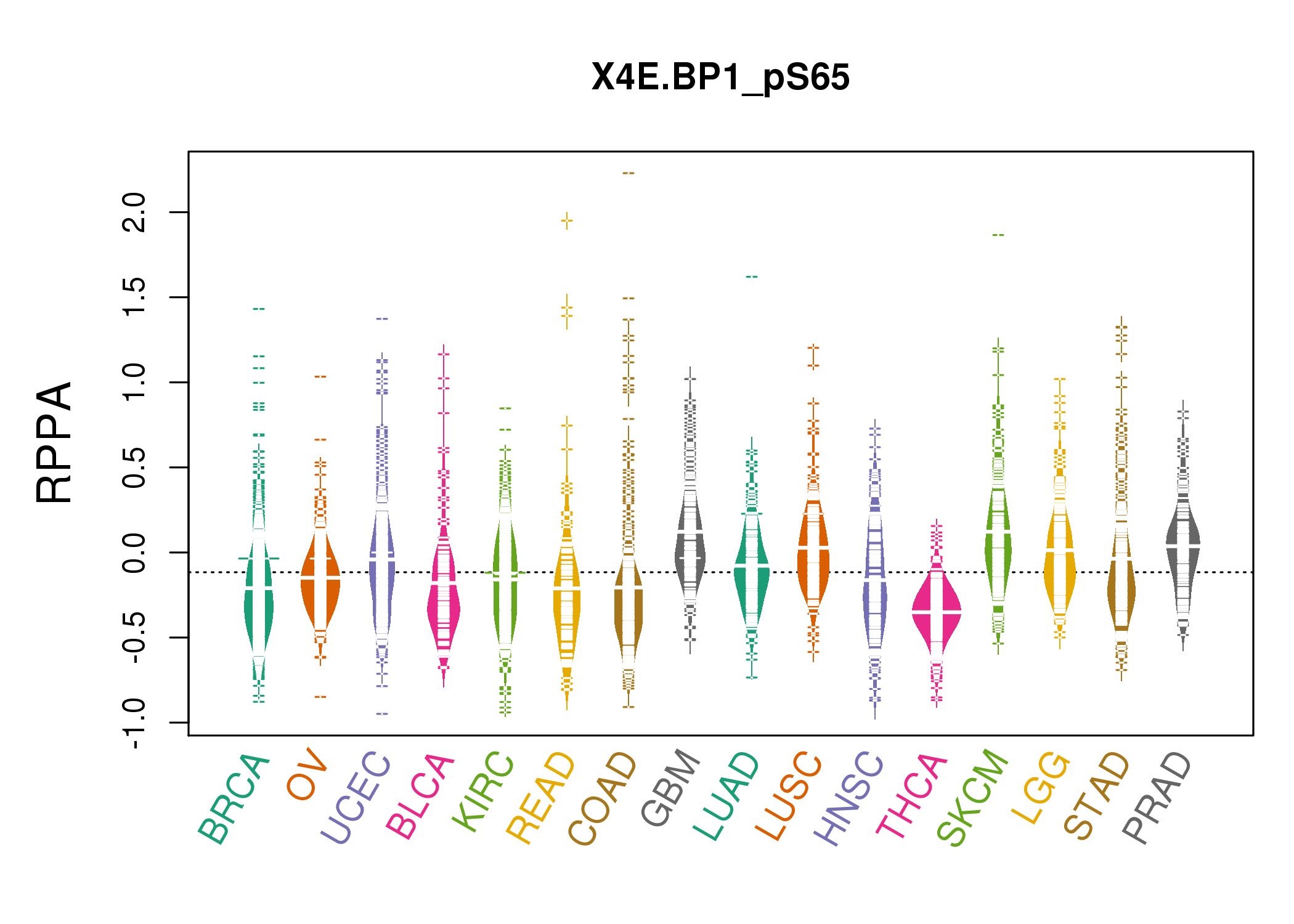 |
 |
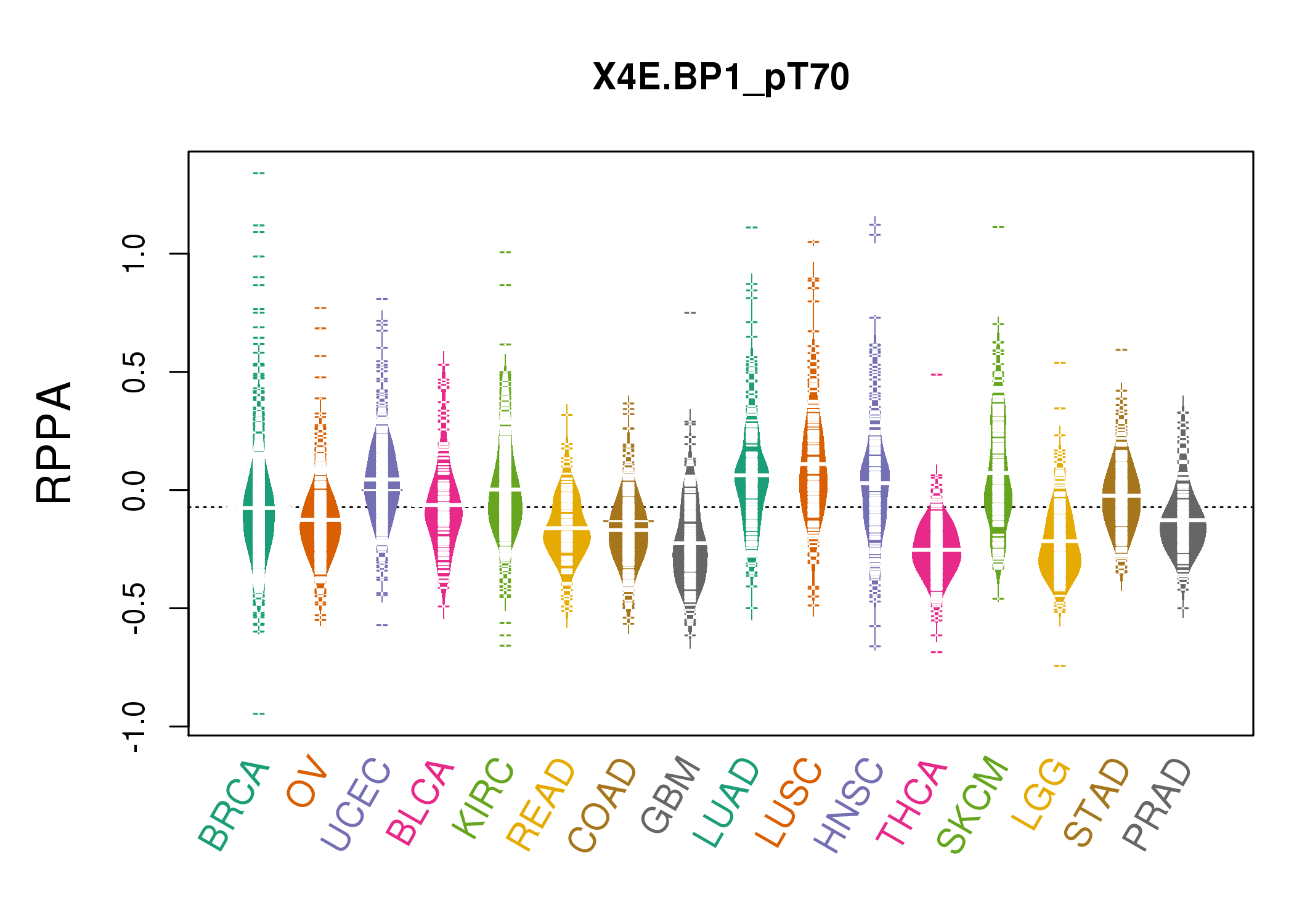 |
 |
| * Normalized gene expression data of RNASeqV2 was extracted from TCGA using R package TCGA-Assembler. The URLs of all public data files on TCGA DCC data server were gathered at Jan-05-2015. Only eight cancer types have enough normal control samples for differential expression analysis. (t test, adjusted p<0.05 (using Benjamini-Hochberg FDR)) |
 |
| Top |
| * This plots show the correlation between CNV and gene expression. |
: Open all plots for all cancer types
 |
|
 |
|
| Top |
| Gene-Gene Network Information |
| * Co-Expression network figures were drawn using R package igraph. Only the top 20 genes with the highest correlations were shown. Red circle: input gene, orange circle: cell metabolism gene, sky circle: other gene |
: Open all plots for all cancer types
 |
| ||||
| ALG3,ASH2L,BOLA3,BRF2,BUD31,ECE2,EIF4EBP1, LSM1,LSM4,MRPS2,NPM3,POLR2H,PPAPDC1B,PROSC, PSMG3,RPL30,SNHG6,SRM,TCEB1,TIMM44,UBE2S | ACSM2B,ASS1,BSG,IZUMO4,C20orf27,EIF4EBP1,FPGS, GCDH,GLYCTK,MEF2B,MPST,NDRG4,PCBD1,PCYT2, PDZD7,PMM1,PQLC1,PXMP2,RASL10B,RPLP2,TMEM120A | ||||
 |
| ||||
| ASH2L,BRF2,CENPM,CYC1,EIF3I,EIF4EBP1,EIF5A, EXOSC4,H2AFZ,KRTCAP3,LSM1,MFSD2B,MRPL12,MRTO4, PROSC,PUSL1,RCC1,RPS6KB2,SRSF9,SRM,ZNF511 | AFMID,C19orf48,C9orf142,CCDC34,EIF4EBP1,EXOSC5,FBXW9, GCAT,MPG,MRPS18A,MRPS26,NAT9,NTHL1,PAFAH1B3, PPP5C,PRPS2,SLC35B2,SSBP4,SYNGR2,TMED3,YIPF2 |
| * Co-Expression network figures were drawn using R package igraph. Only the top 20 genes with the highest correlations were shown. Red circle: input gene, orange circle: cell metabolism gene, sky circle: other gene |
: Open all plots for all cancer types
| Top |
: Open all interacting genes' information including KEGG pathway for all interacting genes from DAVID
| Top |
| Pharmacological Information for EIF4EBP1 |
| DB Category | DB Name | DB's ID and Url link |
| Organism-specific databases | PharmGKB | PA27715; -. |
| Organism-specific databases | CTD | 1978; -. |
| * Gene Centered Interaction Network. |
 |
| * Drug Centered Interaction Network. |
| DrugBank ID | Target Name | Drug Groups | Generic Name | Drug Centered Network | Drug Structure |
| DB00877 | eukaryotic translation initiation factor 4E binding protein 1 | approved; investigational | Sirolimus | 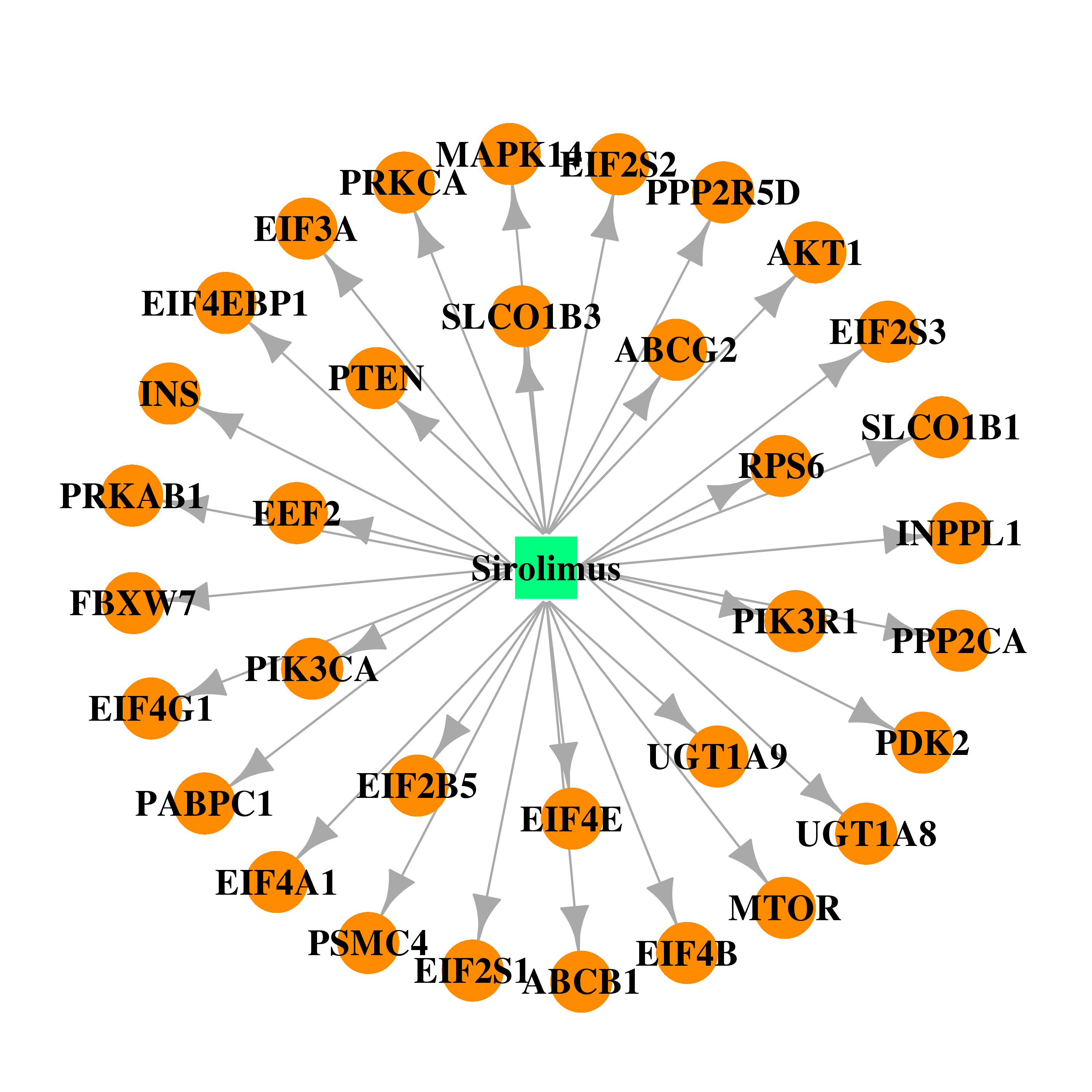 |  |
| Top |
| Cross referenced IDs for EIF4EBP1 |
| * We obtained these cross-references from Uniprot database. It covers 150 different DBs, 18 categories. http://www.uniprot.org/help/cross_references_section |
: Open all cross reference information
|
Copyright © 2016-Present - The Univsersity of Texas Health Science Center at Houston @ |






